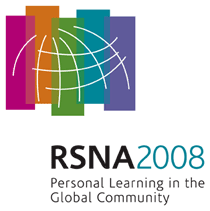
Abstract Archives of the RSNA, 2008
LL-GI4315-R09
Hypervascular Hepatocellular Carcinoma in the Cirrhotic Liver: Diffusion-weighted Imaging versus SPIO-enhanced MR Imaging
Scientific Posters
Presented on December 4, 2008
Presented as part of LL-GI-R: Gastrointestinal
Jin Chung MD, Presenter: Nothing to Disclose
Jeong-Sik Yu MD, Abstract Co-Author: Nothing to Disclose
Jae-Joon Chung MD, Abstract Co-Author: Nothing to Disclose
Joo Hee Kim, Abstract Co-Author: Nothing to Disclose
Ki Whang Kim MD, Abstract Co-Author: Nothing to Disclose
To retrospectively compare diffusion-weighted image (DWI) with superparamagnetic iron oxide (SPIO)-enhanced MR image (MRI) in the evaluation of hypervascular hepatocellular carcinomas (HCCs) in the cirrhotic liver.
Fifty-three consecutive patients (41 men, 12 women; mean age, 56.1 years) were enrolled with 90 hypervascular HCCs in cirrhotic liver (39 B viral cirrhosis, 4 C viral cirrhosis and 10 cryptogenic cirrhosis). All HCCs showed arterial enhancement in dynamic MRI. Nineteen HCCs were surgically confirmed, 6 HCCs were increased in size during follow-up, and 65 HCCs showed tumor staining at TACE with sustaining iodized-oil accumulations in follow-up CT. Two independent observers reviewed DWI (b values of 50, 400 and 800 s/mm2) and SPIO-enhanced MRI for detection and sorting the confidence levels (CLs) for HCCs into 4 grades (negative detection for grade 1 or 2, positive detection for grade 3 or 4). Interpretations of HCCs were devided into 3 groups [group 1 (n = 21), < 1cm; group 2 (n = 33), 1-2cm; group 3 (n = 36), > 2cm in maximum dimension). The Wilcoxon signed rank test was applied for differences between two techniques.
For the 90 hypervascular HCCs, overall detection rate of HCC was 98.9% in DWI and 97.8% in SPIO-enhanced MRI. For group 1, DWI with b value of 50 s/mm2 (p = 0.260) was only comparable with SPIO-enhanced MRI and fell down CL in DWI with high b values (p > 0.05). Group 2 (p = 1.0 and p = 0.001 in b value of 50 and 400 s/mm2, respectively) and group 3 (p = 0.157 and p = 1.0 in b value of 50 and 400 s/mm2, respectively) showed no difference between DWI and SPIO-enhanced MRI, except a marginal difference (p = 0.046) with b value of 800 s/mm2 in group 3.
Even though the overall detection rate can be similar between DWI and SPIO-enhanced MRI, only DWI with b value of 50 s/mm2 would show high CL comparable with SPIO-enhanced MRI, regardless of the lesion size. Conversely, DWI with high b values could not be the alternative of SPIO-enhanced MRI for small HCCs.
Among the DWIs using various b values, DWI with b value of 50 s/mm2, comparable to SPIO-enhanced MRI, is essential for assessment of small HCCs in cirrhotic liver.
Chung, J,
Yu, J,
Chung, J,
Kim, J,
Kim, K,
Hypervascular Hepatocellular Carcinoma in the Cirrhotic Liver: Diffusion-weighted Imaging versus SPIO-enhanced MR Imaging. Radiological Society of North America 2008 Scientific Assembly and Annual Meeting, February 18 - February 20, 2008 ,Chicago IL.
http://archive.rsna.org/2008/6014256.html

